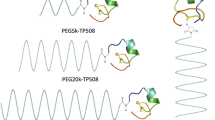Background and Purpose:
The efficacy of radiotherapy is limited by the response of normal tissues within the radiation field. The application of normal-tissue-specific radioprotectors may improve the therapeutic benefit of radiotherapy. The purpose of the present study was to explore the in vivo normal-tissue radioprotective potential of Bowman-Birk proteinase inhibitor (BBI), which acts as a normal-cell-specific radioprotector in vitro.
Material and Methods:
The leg contracture assay in mice, a model system assessing radiation-induced fibrotic processes, was used. To determine whether BBI acts also as a radioprotector of tumors (i. e., FSA and FSAII), the tumor growth delay assay was used.
Results:
Radiation induced leg contracture in mice with a maximum of about 8 mm at day 150 after irradiation. Treatment of mice with 100 mg/kg BBI before irradiation reduced leg contracture by > 4 mm, by about 50% (p < 0.05, t-test). Doses < 100 mg/kg were ineffective, and doses > 100 mg/kg did not further increase the degree of radioprotection. By contrast, BBI did not induce radioprotection of either TP53-mutated FSA or TP53-normal FSAII tumor xenografts in mice, which argues for normal-tissue-specific effect.
Conclusion:
BBI acts as a potent selective normal-tissue radioprotector in vitro and in vivo, apparently without protecting tumors, and thus has the potential to improve clinical radiotherapy.
Hintergrund und Ziel:
Der Erfolg einer radioonkologischen Therapie wird häufig durch die Reaktion des Normalgewebes im Bestrahlungsfeld limitiert. Der Einsatz von normalgewebespezifischen Radioprotektoren könnte den therapeutischen Vorteil einer Radiotherapie weiter vergrößern. Ziel der vorliegenden Arbeit war die Überprüfung des radioprotektiven Potentials des Bowman-Birk-Proteinase-Inhibitors (BBI) in vivo. Dieser Radioprotektor wurde in vitro bereits als normalgewebespezifisch beschrieben.
Material und Methodik:
Als Tiermodell für strahleninduzierte fibrotische Prozesse wurde der „Beinverkürzungsassay“ in Mäusen gewählt. Zur Überprüfung möglicher radioprotektiver Effekte in Tumoren wurde der „Tumorwachstumsverzögerungsassay“ mit zwei Fibrosarkomen (FSA, FSAII) in Mäusen verwendet.
Ergebnisse:
Die strahleninduzierte Beinverkürzung bei Mäusen erreichte 150 Tage nach der Bestrahlung ein Maximum von 8 mm. Eine Behandlung der Mäuse mit einer BBI-Dosis von 100 mg/kg vor der Bestrahlung reduzierte die Beinverkürzung um > 4 mm (50%; p < 0,05, t-Test). Dosen < 100 mg/kg waren ineffektiv, und Dosen > 100 mg/kg waren nicht in der Lage, den radioprotektiven Effekt weiter zu steigern. Im Gegensatz dazu zeigte BBI sowohl bei Xenografttumoren mit mutiertem TP53 als auch bei Tumoren mit Wildtyp-TP53 keine Radioprotektion. Dieser Befund spricht für eine Normalgewebespezifität.
Schlussfolgerung:
BBI wirkt in vitro und in vivo als potenter normalgewebespezifischer Radioprotektor, offensichtlich ohne Tumoren zu schützen, und hat so das Potential, den Erfolg der Radiotherapie weiter zu verbessern.
Similar content being viewed by others
Author information
Authors and Affiliations
Corresponding author
Rights and permissions
About this article
Cite this article
Dittmann, K., Toulany, M., Classen, J. et al. Selective Radioprotection of Normal Tissues by Bowman-Birk Proteinase Inhibitor (BBI) in Mice. Strahlenther Onkol 181, 191–196 (2005). https://doi.org/10.1007/s00066-005-1358-y
Received:
Accepted:
Issue Date:
DOI: https://doi.org/10.1007/s00066-005-1358-y




